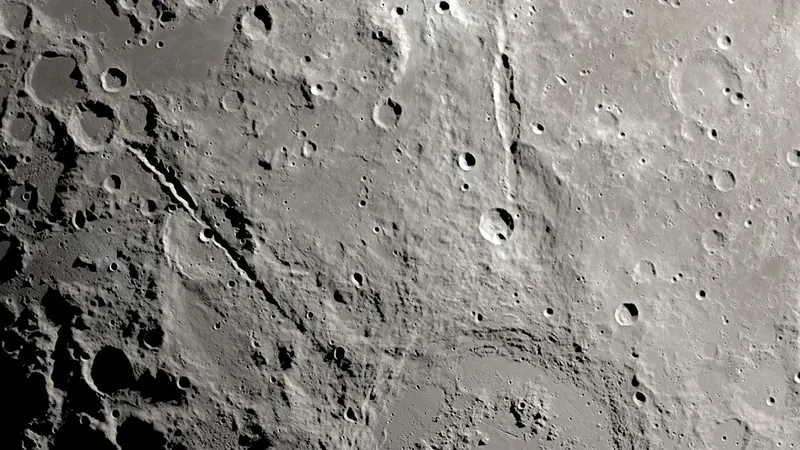
Shocking Discovery: Massive Impact Event Shaped the Moon's South Pole!
2025-04-01
Author: Sarah
Introduction
About 3.81 billion years ago, a colossal impactor struck the Moon's south pole, leading to the formation of the iconic Schrödinger impact basin, which remains an essential feature of lunar geology today. This event is not just a relic of the past; it provides a window into the dynamic processes that shaped our celestial neighbor.
Cataclysmic Event
Recent observations by astronomers have uncovered that this cataclysmic event created two exceptionally deep valleys stretching away from the crater. These valleys, Vallis Schrödinger and Vallis Planck, were formed rapidly by rocks thrown outward during the impact, resulting in a landscape that's reminiscent of the Grand Canyon on Earth, yet formed within a mere 10 minutes rather than millions of years. Danielle Kallenborn, a planetary scientist at Imperial College London, emphasized the significance of these findings: “The debris reimpact the surface—boom, boom, boom—and form this line of individual craters.”
Dimensions of the Valleys
The length and depth of these valleys are astounding. Vallis Schrödinger and Vallis Planck extend approximately 270 to 280 kilometers long and reach depths of about 2.7 to 3.5 kilometers, making them half as long as the Grand Canyon but significantly deeper. Kallenborn’s study, published in *Nature Communications*, identifies 15 secondary craters in Vallis Schrödinger and even more in Vallis Planck, a reflection of the event's violent nature.
Velocity of Ejected Debris
The analysis revealed that the debris was ejected at incredible speeds of 3,420 to 4,610 kilometers per hour, as shock waves from the impact propagated outward—an explosion millions of times more powerful than the atomic bomb dropped on Hiroshima. Researchers concluded that debris landed back on the surface roughly 5 to 15 minutes after being launched; Kallenborn noted, “You could look and see them flying through the air.”
Orientation of the Impact
What’s more, the valleys' orientation indicates that the impactor approached from the north-northwest at an angle of less than 45 degrees. Most ejecta was propelled away from the Moon's south pole, which is encouraging news for NASA’s Artemis mission plans to explore this area. Kallenborn expressed relief that collected samples are likely to be older lunar materials rather than fragments from the impactor.
Significance of the Schrödinger Basin
The Schrödinger basin is particularly crucial because it represents one of the last significant basins formed during the early solar system's tumultuous times. Scientists are keen on studying rocks that formed closer to the Moon's original creation around 4.5 billion years ago, which could provide insights into the Earth-Moon formation event and the history of the solar system itself.
Parallels in the Solar System
In addition to the excitement surrounding this research, Kelsi Singer, a planetary scientist from the Southwest Research Institute, pointed out parallels with other celestial bodies, such as the Falsaron Crater on Saturn's moon Iapetus, which also displays similar secondary crater formations. This fascinating similarity across the solar system invites further investigation into the mechanics of impact events.
Future Explorations
With the Artemis missions slated for this decade, the exploration of the Moon continues to promise transformative discoveries that could reshape our understanding of planetary formation and the history of our celestial neighborhood. The Schrödinger impact basin, with its striking features and intriguing geological history, remains a prime target for future studies.
Conclusion
Stay tuned as we uncover more about the Moon, the mysteries of our solar system, and what new technologies will reveal!
 Brasil (PT)
Brasil (PT)
 Canada (EN)
Canada (EN)
 Chile (ES)
Chile (ES)
 Česko (CS)
Česko (CS)
 대한민국 (KO)
대한민국 (KO)
 España (ES)
España (ES)
 France (FR)
France (FR)
 Hong Kong (EN)
Hong Kong (EN)
 Italia (IT)
Italia (IT)
 日本 (JA)
日本 (JA)
 Magyarország (HU)
Magyarország (HU)
 Norge (NO)
Norge (NO)
 Polska (PL)
Polska (PL)
 Schweiz (DE)
Schweiz (DE)
 Singapore (EN)
Singapore (EN)
 Sverige (SV)
Sverige (SV)
 Suomi (FI)
Suomi (FI)
 Türkiye (TR)
Türkiye (TR)
 الإمارات العربية المتحدة (AR)
الإمارات العربية المتحدة (AR)